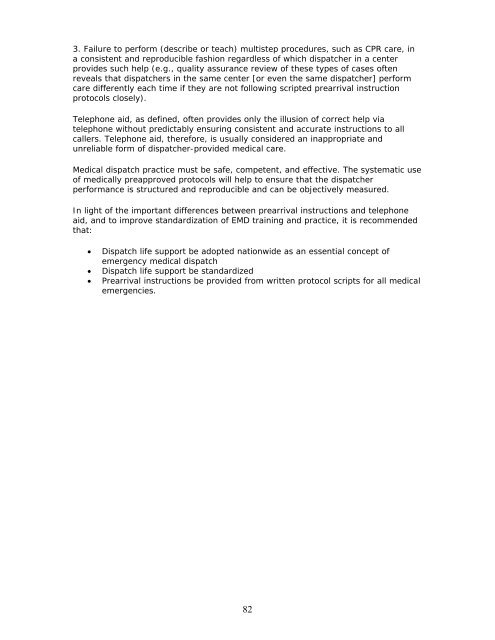Standard Practice for Emergency Medical Dispatch ... - NHTSA
Standard Practice for Emergency Medical Dispatch ... - NHTSA Standard Practice for Emergency Medical Dispatch ... - NHTSA
3. Failure to perform (describe or teach) multistep procedures, such as CPR care, in a consistent and reproducible fashion regardless of which dispatcher in a center provides such help (e.g., quality assurance review of these types of cases often reveals that dispatchers in the same center [or even the same dispatcher] perform care differently each time if they are not following scripted prearrival instruction protocols closely). Telephone aid, as defined, often provides only the illusion of correct help via telephone without predictably ensuring consistent and accurate instructions to all callers. Telephone aid, therefore, is usually considered an inappropriate and unreliable form of dispatcher-provided medical care. Medical dispatch practice must be safe, competent, and effective. The systematic use of medically preapproved protocols will help to ensure that the dispatcher performance is structured and reproducible and can be objectively measured. In light of the important differences between prearrival instructions and telephone aid, and to improve standardization of EMD training and practice, it is recommended that: • Dispatch life support be adopted nationwide as an essential concept of emergency medical dispatch • Dispatch life support be standardized • Prearrival instructions be provided from written protocol scripts for all medical emergencies. 82
MEDICAL DISPATCHER TRAINING Formal EMD training contributes to the safe and effective performance of the medical dispatcher's role in EMS. Guidelines for the core content of EMD courses are currently being standardized by the ASTM. These guidelines will provide direction for the training (and certification) of EMD's regarding appropriate decisions about EMS responses in a safe, consistent, and nonarbitrary manner. Within the context of this broad goal, current EMD training is generally at least 24 hours in length (e.g., three 8-hour days). A typical course consists of an overview of dispatching objectives and basic dispatch techniques, concentrating on known problem areas. The role of the EMD is defined, and the concepts of medical dispatching are discussed in detail. The medical dispatch protocol in use by the sponsoring EMS agency is learned, with emphasis on interrogation skills, protocol compliance, and the provision of prearrival instructions. Common medical problems are reviewed, with an emphasis on interrogation specifics for each type of problem, and the relevance and relationship of listed prearrival instructions. Throughout the training, the importance of identifying the presence or absence of symptoms (such as "chest pain") during interrogation is emphasized, rather than making a judgmental diagnosis of "heart attack." The medical significance of the various levels of urgency for each chief complaint and its resultant response is clarified to give the student the ability to prioritize quickly the various types of incidents confronting EMD's daily. Often, courses use mock case drills to give the dispatcher a hands-on feel of protocol performance. A formal examination to test student understanding and assimilation of the curriculum should me administered at the completion of an EMD course. This enables formal certification in jurisdictions requiring or allowing it. It is recommended that EMD training: • Be required for all medical dispatchers • Be consistent in core curriculum content nationally • Be based on the medical dispatch protocol selected and approved by the sponsoring agency's physician medical director, allowing for practice use of the protocol by the EMD trainee. 83
- Page 1 and 2: Appendix G 1a: Elements of an Emerg
- Page 3 and 4: 5. pre-arrival instructions-telepho
- Page 5 and 6: 5. Significance and Use 1. The emer
- Page 7 and 8: 1. Compliance to asking the systema
- Page 9 and 10: 11. Reciprocal Certification 1. Rec
- Page 11 and 12: 6. EMS Field Experience-Miscellaneo
- Page 13 and 14: 1. Selection of an EMDPRS by the ov
- Page 15 and 16: emergency medical dispatchers (EMD'
- Page 17 and 18: ISSUES AND RECOMMENDATIONS FOR EMER
- Page 19 and 20: ambulances in 1990, it is medically
- Page 21: status of consciousness and breathi
- Page 25 and 26: epresent dispatch-related problems
3. Failure to per<strong>for</strong>m (describe or teach) multistep procedures, such as CPR care, in<br />
a consistent and reproducible fashion regardless of which dispatcher in a center<br />
provides such help (e.g., quality assurance review of these types of cases often<br />
reveals that dispatchers in the same center [or even the same dispatcher] per<strong>for</strong>m<br />
care differently each time if they are not following scripted prearrival instruction<br />
protocols closely).<br />
Telephone aid, as defined, often provides only the illusion of correct help via<br />
telephone without predictably ensuring consistent and accurate instructions to all<br />
callers. Telephone aid, there<strong>for</strong>e, is usually considered an inappropriate and<br />
unreliable <strong>for</strong>m of dispatcher-provided medical care.<br />
<strong>Medical</strong> dispatch practice must be safe, competent, and effective. The systematic use<br />
of medically preapproved protocols will help to ensure that the dispatcher<br />
per<strong>for</strong>mance is structured and reproducible and can be objectively measured.<br />
In light of the important differences between prearrival instructions and telephone<br />
aid, and to improve standardization of EMD training and practice, it is recommended<br />
that:<br />
• <strong>Dispatch</strong> life support be adopted nationwide as an essential concept of<br />
emergency medical dispatch<br />
• <strong>Dispatch</strong> life support be standardized<br />
• Prearrival instructions be provided from written protocol scripts <strong>for</strong> all medical<br />
emergencies.<br />
82



